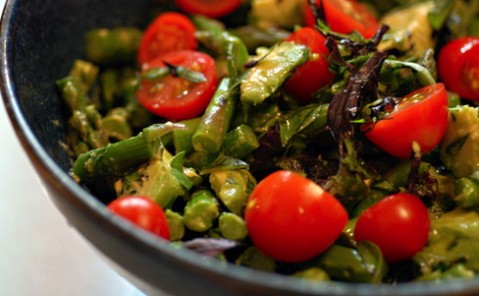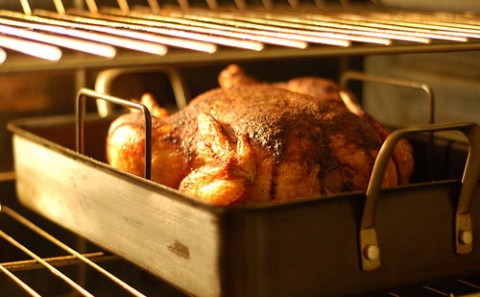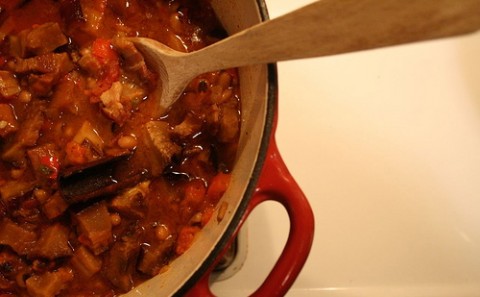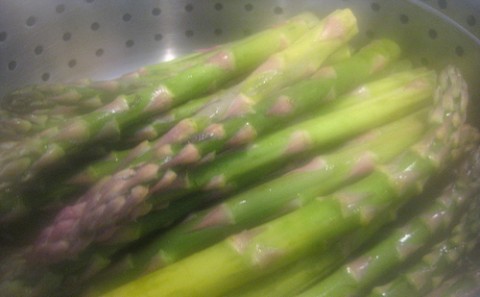
It’s easy to get overwhelmed when you first learn how to cook.
All the equipment! All the recipes! And what the hell are all these ingredients I’ve never heard of?
As complex as cooking is often portrayed, it really boils down to just a couple of simple tasks.
When you break it down, cooking is really the mastery of two skills:
- Using a knife to cut food up
- Using heat to cook food up
That’s it!
And if half the battle is learning how to heat food up, then there’s only four techniques you as a beginner need to learn:
- Frying
- Roasting
- Boiling
- Steaming
Most things you’ll ever cook use just one of these techniques.
The Zen of Cooking is a “top secret” practice of understanding the few simple ways that you can heat up food into a tasty meal.
And by understanding what they are and how to best use them, you can quickly demystify cooking and get over the fears that are holding you back from succeeding.
0. Going Raw

Okay, this doesn’t technically count as a cooking technique, but it’s important to make note of for several reasons.
First off, eating raw food means you save yourself valuable time in the kitchen. (Hooray!)
But also, many types of food are just better raw than they ever will be cooked, such as:
- Fibrous vegetables like lettuce, cucumbers, and radishes
- Most fruits
- Dairy and dairy products
You can eat a lot of other things raw, but I’m not a fan of taking things to an extreme and eating only raw foods.
And who really wants to give up steak and potatoes, anyway?
When it comes to salads, fresh fruit, and dairy products such as cheese and yogurt, raw is your best bet.
1. Frying

Frying, or cooking over high heat in an open environment, is probably the oldest cooking method.
It would have been simple once our ancestors had tamed fire to throw some meat on the hot rocks removed from the flames and realize that the results were delicious.
These days, you’re much more likely to do your frying in a nice flat pan. You’ll also use some cooking oil to ensure the food cooks more evenly, crisps up, and is extra flavorful.
Frying is best used for thin cuts of meat and small chunks of vegetables and is therefore a quick process.
As a result, frying is one of the best ways to quickly get a quality meal thrown together during the week.
Just get a pan hot, add in some fat or oil, then add in some veggies and fry until cooked, stirring occasionally. Then add in some meat and fry until cooked as well.
With frying alone, you can throw together a solid dinner in just 20 minutes.
There’s a lot of dishes that you can create with frying. Here’s some examples:
- Fried cuts of meat such as steaks, pork chops, fish fillets, and chicken pieces
- Fried veggies such as green beans, broccoli, cauliflower, and potatoes
- Stir-frys
- Scrambled eggs and omelettes
- Bacon and sausage
Frying is a quick way of cooking up a small amount of meat and vegetables. It is one of the quickest ways to throw together a weekday dinner.
2. Roasting

Roasting is cooking over low heat in a closed environment, and in many ways is the opposite of frying.
With roasting, you can cook up a massive amount of food with relatively little labor, which makes it ideal for those who prefer to cook in bulk during the weekend so they don’t have to during the week.
Roasting is an ideal cooking method for large roasts and starchy roots and tubers such as potatoes, which are much cheaper than the steaks and fillets you’d normally use for frying.
For me, roasting is a cold-weather activity. It really warms up your house, which I try to avoid when it’s hot outside.
You can use a basic pot or pan for roasting, but I prefer using metal or glass roasting pans. They are easy to work with and can hold a lot of food.
These are some great meals to roast:
- Roast beef or pork
- Roast whole chicken
- Roast roots and tubers such as potatoes, sweet potatoes, and carrots
- Roast squash
Roasting is a great way to make a lot of food at once so you don’t have to later. It is ideal when you’ve got some spare time on the weekend during fall and winter.
3. Boiling

Boiling is cooking in a boiling liquid, and requires a deep pot rather than a shallow pan.
Boiling is what you do when you make the following types of meals:
- Pot roast
- Soup
- Stew
- Chili
- Rice and/or beans
- Boiled veggies (potatoes, cabbage, kale, collards)
Like roasting, boiling is an ideal way of cooking a lot of food with little labor.
Also like roasting, it uses long cooking times to soften even the toughest of cuts of meat and veggies.
I eat a lot of pot roast, soup, and stew during the cooler months, and so make extensive use of boiling. But I’ll also use it for vegetables and rice and beans year-round.
Boiling will provide you with soups and stews during the colder months, but is always ideal for slow-cooked veggies, rice, and beans.
4. Steaming

The last thing you should try to master as a beginner is something that is all too often overlooked.
Steaming is cooking in the vapor of boiling liquid, instead of in the liquid when you are boiling.
Since boiling liquid is at the same temperature as its vapor, boiling and steaming are very similar cooking techniques.
But since steaming is faster to set-up and clean up, I usually use it for quick-cooking vegetables such as green beans, asparagus, broccoli, and cauliflower, which take about 5 minutes to cook.
To steam, you’ll only need a steaming basket (available at most supermarkets) to use in a covered pot.
On the other hand, I’ll use boiling for any vegetable that I want to give a long cook, such as potatoes and other starches, or greens that I want to cook until very soft.
Steaming is a quick and easy way of cooking vegetables that too many people forget about.
Cooking: It Ain’t As Complex As It Looks
It’s easy to be intimidated by cooking if you never learned but are eager to start.
But there’s a lot less to it than you probably realize.
The Zen of Cooking is a way of looking at the basic cooking methods that makes them much less intimidating and more beginner-friendly.
Using heat to transform your food into something edible, digestible, and just plain tasty involves mastering only four cooking skills:
- Frying
- Roasting
- Boiling
- Steaming
Yes, there are other ways of cooking, but 99% of what you’ll ever make in the kitchen will fall into one or two of these categories.
And once you can use these four cooking techniques, you can prepare just about anything.
 I'm a science geek, food lover, and wannabe surfer.
I'm a science geek, food lover, and wannabe surfer.
{ 2 comments }
Darrin,
Thanks for encouraging those of us who are slightly more “challenged” in the kitchen to give cooking a go! It’s really not too bad once you get the hang of the basics. For me, the simpler the better. The skillet and slow cooker are my two most used pieces of equipment.
Alykhan
@Alykhan,
Yes! Once you have the basics down (of which there are surprisingly few), you can throw together ANYTHING!
Comments on this entry are closed.